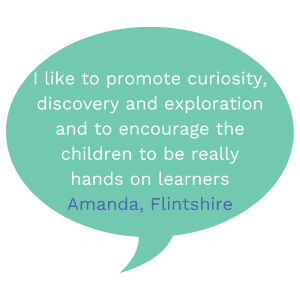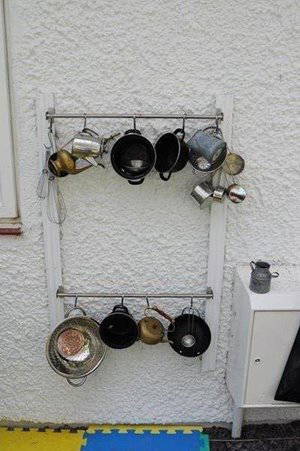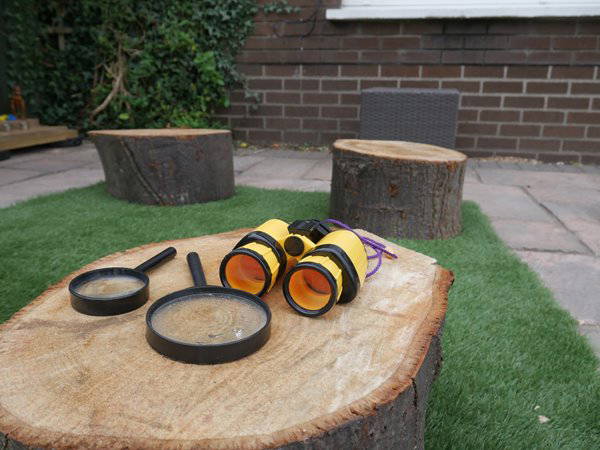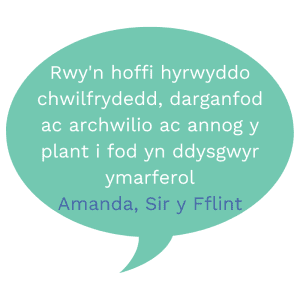Exploring and combining some of the key points in this section will help as you review and enhance the resource offer for your children in a responsive way over time. Digest and use the ideas here to trigger questions, reflection and also new thinking as you continually notice and consider how well your resources, materials and experiences are meeting their needs. Don’t forget to document the process of review and development as this will feed into your future-planning and is a great way to capture the changes made and impact noticed.
“The language we use to describe our resource offer carries meaning. Materials conveys the idea of textures or perhaps unconventional ’things’ to combine those that are open ended. Experiences conveys the idea of the process being important, not always an end-product.”
Elizabeth Jarman
Linking your vision to resources
We talked about the importance of a vision in the Creating effective spaces section. The vision you have for the children in your setting will influence the kinds of resources you have on offer and also the way they are organised. If for example you want children to develop their ideas independently, resources could be organised so they are more easily accessible. Making this connection between vision and the environment is key. Once you are clear about your vision you are ready to audit your resources, identify what you might no longer need and any gaps in provision.
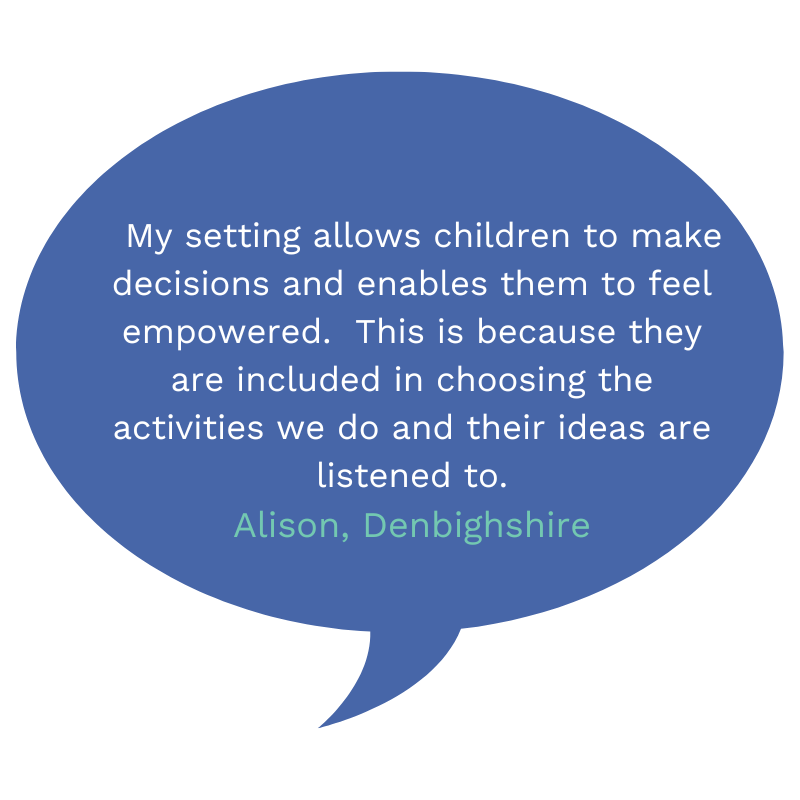
Linking your vision to resources
We talked about the importance of a vision in the Creating effective spaces section. The vision you have for the children in your setting will influence the kinds of resources you have on offer and also the way they are organised. If for example you want children to develop their ideas independently, resources could be organised so they are more easily accessible. Making this connection between vision and the environment is key. Once you are clear about your vision you are ready to audit your resources, identify what you might no longer need and any gaps in provision.

Storage and presentation
Before we start looking at what you have on offer it’s important to think about how things are arranged and managed currently, then identify if you need to make any changes to your storage and presentation.
As you are well aware working from your home, storage and resource management is even more important than perhaps in a larger type setting with more space. There’s the constant tension between it being a childcare setting and also a home.
There is a challenge in ensuring you do not store too many things in the children’s space as it can create a feeling of sensory overload if you do. This can impact negatively on children’s ability to focus, sort and select things they want to use. Before you start adding more resources to your environment, take time to de-clutter, reducing visual distraction. If you have limited storage, ‘hide’ or screen resources you don’t need to access every day, maybe with a curtain. Then really look at your space from the child’s perspective and consider how this may feel.
Think about practical ways to facilitate choice when the resources that children might want aren’t out. Presentation of resources is important. Focus on one area of your provision with this in mind. Do you notice a difference in the way the children engage when you have really considered the presentation?
Materials and schemas
The selection of materials made available in your setting will ideally connect with and enhance your children’s interests and fascinations. These might be through the use of schemas. PACEY’s Spotlight on Schemas has further information. It is likely these will influence your resource choices significantly. For example, if you have a child with a ‘trajectory’ schema, they will be interested in all things that move, including themselves! They might like materials that move too. This could include water you can spray or hose, cardboard tubes that can be knocked over and balls that can be rolled.
It’s easy to make incorrect assumptions about what children enjoy playing with. Watch, listen and reflect. Keen observation of what children are trying to do will help you know what resources to add. Chat to families to find out how children spend their time at home and what they like using there and also remember to listen to the voice of the child.
Open ended opportunities
Offering non-prescriptive resources inside and out will encourage children’s imaginations to flourish. The same resources can be used in a wide variety of ways by children at different stages of development and also satisfy schematic interests.
Consider the use of the following open-ended resources:
- Different sized wooden or cardboard reels
- Off cuts of wood, e.g. decking
- Carpet squares
- Cardboard boxes and tubes
- Wooden circular curtain rings
- Wooden pegs and wooden spoons
- Pieces of textured material
- Ribbons and zips
Sourcing these items often relies on keeping your eyes peeled for bargains, maybe at car boot sales, charity shops, scrap stores or online. Connecting with local businesses can be a great way to access some of the items listed. Parents/carers might have useful contacts too, which will lead to conversations about why open-ended play is so beneficial.
Sensory opportunities
Creating a sensory learning environment is a really important consideration and requires careful planning. We know from research just how important this is in terms of supporting healthy brain growth and development. Ideally, just by being in your environment children will be exposed to lots of sensory experiences, different textures, surfaces and so on. Striking the right balance however is key as it’s easy to go overboard, which can lead to sensory overload.
Theorist Piaget said that children need environmental stimuli and experiences to guide their cognitive development. Through sensory play, he suggested that children digest new knowledge and store it for later reference. In essence, he argued that this type of play was key to a child’s brain development.
Suggestions for sensory materials include:
- Sand, water, clay and mud
- Natural resources like leaves, pine-cones, shells, conkers and pebbles
- Herbs, flowers, petals and seeds
- Cooking and baking ingredients for example dried spices, flour, cocoa powder, cornflour, rice, pasta
Please ensure you consider the risks involved in the use of any resources and ensure they are suitable for the age, stage of development and individual needs of the children in your care. The Food and Nutrition Guidance for Wales has information about the use of food in play alongside guidance in the Safer food, better business for childminders published by the Food Standards Agency.
Remember!
- Be careful not to overload children’s senses
- Think carefully about storage and presentation of resources and materials
- Facilitate choice for children
- Observe, reflect and review
There’s a lot to digest in this section. You’ll already be doing some of what’s been featured. If there are changes you want to make, don’t feel you need to do everything at once. Too much change can unsettle children and you also need to keep things manageable for you. Make sure you celebrate and share the things that are going well and the impact you are noticing.
Reflect!
- Think about the vision you have set for your setting? Is it supported through the resources on offer in your setting and way they are accessed?
- Imagine you are one of your children and have an idea about something you want to make today. What might you need? Where can you access those things? Where can you work? How easy is it to find what you want? Is that allowed? Does your setting encourage this sort of child-led activity?
- What schematic behaviours have you noticed in your children? Watch, listen and reflect.
- Pause for a moment and think about your current environment in terms of the opportunities available to engage the sense of touch, taste, smell, sight and hearing. Without overloading the senses, do you need to incorporate more sensory experience into the daily experiences your children have?
Further reading
- I Made a Unicorn- open-ended play with blocks and simple materials
- How sensory play benefits the development of language and communication
- Sensory differences- a guide for all audiences, National Autistic Society
- Evaluation of a pilot sensory play intervention to increase fruit acceptance
- Safer food, better business for childminders
- Food and Nutrition for Childcare settings
- PACEY – CEY smart
Bydd archwilio a chyfuno rhai o’r pwyntiau allweddol yn yr adran hon o gymorth wrth ichi esblygu’ch lle mewn ffordd ymatebol dros amser. Ystyriwch a defnyddiwch y syniadau yma i sbarduno cwestiynau, myfyrio a hefyd ffordd newydd o feddwl wrth i chi sylwi’n barhaus ac ystyried pa mor dda y mae eich amgylchedd yn diwallu anghenion plant dan eich gofal. Peidiwch ag anghofio dogfennu’r broses adolygu a datblygu gan y bydd hyn yn bwydo i mewn i’ch cynllunio ar gyfer y dyfodol ac mae’n ffordd wych o gipio’r newidiadau a wnaed a’r effaith y sylwyd arni.
"Mae ystyr i'r iaith a ddefnyddiwn i ddisgrifio ein cynnig adnoddau. Mae deunyddiau'n cyfleu'r syniad o weadau neu 'bethau' anghonfensiynol efallai i gyfuno'r rhai penagored. Mae profiadau yn cyfleu'r syniad bod y broses yn bwysig, nid bob amser yn gynnyrch terfynol."
Elizabeth Jarman
Cysylltu'ch gweledigaeth ag adnoddau
Buom yn siarad am bwysigrwydd gweledigaeth yn yr adran Creu lleoedd effeithiol. Bydd y weledigaeth sydd gennych ar gyfer y plant yn eich lleoliad yn dylanwadu ar y mathau o adnoddau sydd gennych i’w cynnig a hefyd y ffordd maen nhw’n cael eu trefnu. Er enghraifft, os ydych chi eisiau i blant ddatblygu eu syniadau yn annibynnol, gellid trefnu adnoddau fel eu bod yn haws eu cyrraedd. Mae gwneud y cysylltiad hwn rhwng gweledigaeth a’r amgylchedd yn allweddol. Unwaith y byddwch yn glir ynghylch eich gweledigaeth, rydych yn barod i archwilio’ch adnoddau, adnabod yr hyn na fydd ei angen arnoch mwyach ac unrhyw fylchau yn y ddarpariaeth

Cysylltu'ch gweledigaeth ag adnoddau
Buom yn siarad am bwysigrwydd gweledigaeth yn yr adran Creu lleoedd effeithiol. Bydd y weledigaeth sydd gennych ar gyfer y plant yn eich lleoliad yn dylanwadu ar y mathau o adnoddau sydd gennych i’w cynnig a hefyd y ffordd maen nhw’n cael eu trefnu. Er enghraifft, os ydych chi eisiau i blant ddatblygu eu syniadau yn annibynnol, gellid trefnu adnoddau fel eu bod yn haws eu cyrraedd. Mae gwneud y cysylltiad hwn rhwng gweledigaeth a’r amgylchedd yn allweddol. Unwaith y byddwch yn glir ynghylch eich gweledigaeth, rydych yn barod i archwilio’ch adnoddau, adnabod yr hyn na fydd ei angen arnoch mwyach ac unrhyw fylchau yn y ddarpariaeth

Storio a chyflwyno
Cyn i ni ddechrau edrych ar yr hyn sydd gennych i’w gynnig, mae’n bwysig meddwl am sut mae pethau’n cael eu trefnu a’u rheoli ar hyn o bryd, yna adnabod a oes angen i chi wneud unrhyw newidiadau i’ch storfa a’ch cyflwyniad.
Fel y gwyddoch yn iawn mae gweithio o’ch cartref, storio a rheoli adnoddau hyd yn oed yn bwysicach nag efallai mewn lleoliad mwy o faint gyda mwy o le. Mae tensiwn cyson rhwng bod yn lleoliad gofal plant a hefyd yn gartref.
Mae her wrth sicrhau nad ydych chi’n storio gormod o bethau yn lle’r plant oherwydd gall greu teimlad o orlwytho synhwyraidd os gwnewch chi hynny. Gall hyn gael effaith negyddol ar allu plant i ganolbwyntio, didoli a dewis pethau maen nhw am eu defnyddio. Cyn i chi ddechrau ychwanegu mwy o adnoddau i’ch amgylchedd, cymerwch amser i dacluso, gan leihau’r pethau sy’n tynnu sylw. Os oes gennych storfa gyfyngedig, ceisiwch ‘guddio’ neu sgrinio adnoddau nad oes eu hangen arnoch bob dydd, efallai gyda llen. Yna edrychwch o ddifri ar eich gofod o safbwynt y plentyn ac ystyriwch sut y gallai hyn deimlo.
Meddyliwch am ffyrdd ymarferol o hwyluso dewis pan nad yw’r adnoddau y gallai plant fod eu heisiau allan. Mae cyflwyniad adnoddau yn bwysig. Canolbwyntiwch ar un maes o’ch darpariaeth gyda hyn mewn golwg. Ydych chi’n sylwi ar wahaniaeth yn y ffordd y mae’r plant yn ymgysylltu pan rydych chi wir wedi ystyried y cyflwyniad?
Deunyddiau a sgemâu
Yn ddelfrydol, bydd y dewis o ddeunyddiau sydd ar gael yn eich lleoliad yn cysylltu â diddordebau a chyfareddau eich plant ac yn eu gwella. Gall y rhain fod trwy ddefnyddio sgemâu. Mae gan Sbotolau ar Sgemâu PACEY wybodaeth bellach. Mae’n debygol y bydd y rhain yn dylanwadu’n sylweddol ar eich dewisiadau adnoddau. Er enghraifft, os oes gennych blentyn gyda sgema ‘trywydd’, bydd ganddo ddiddordeb ym mhob peth sy’n symud, gan gynnwys eu hunain! Efallai yr hoffent ddeunyddiau sy’n symud hefyd. Gallai hyn gynnwys dŵr y gallwch ei chwistrellu, tiwbiau cardbord y gellir eu taro drosodd a pheli y gellir eu rholio.
Mae’n hawdd gwneud rhagdybiaethau anghywir ynglŷn â’r hyn y mae plant yn mwynhau chwarae ag ef. Gwyliwch, gwrandwch a myfyriwch. Bydd arsylwi craff ar yr hyn y mae plant yn ceisio ei wneud yn eich helpu i wybod pa adnoddau i’w hychwanegu. Sgwrsiwch â theuluoedd i ddarganfod sut mae plant yn treulio’u hamser gartref a beth maen nhw’n hoffi ei ddefnyddio yno a chofiwch wrando ar lais y plentyn hefyd.
Cyfleoedd penagored
Bydd cynnig adnoddau an-ragnodol y tu mewn ac yn yr awyr agored yn annog dychymyg plant i ffynnu. Gellir defnyddio’r un adnoddau mewn amrywiaeth eang o ffyrdd gan blant ar wahanol gamau datblygu a hefyd i fodloni diddordebau sgematig.
Ystyriwch ddefnyddio’r adnoddau penagored canlynol:
- Riliau pren neu gardbord o wahanol feintiau
- Toriadau o bren, e.e. deciau
- Sgwariau carped
- Bocsys a thiwbiau cardbord
- Cylchoedd llenni crwn pren
- Pegiau pren a llwyau pren
- Darnau o ddeunydd gweadog
- Rhubanau a sipiau
Mae cael gafael ar yr eitemau hyn yn aml yn dibynnu ar gadw’ch llygaid am fargeinion, efallai mewn sêl cist car, siopau elusennol, siopau sgrap neu ar-lein. Gall cysylltu â busnesau lleol fod yn ffordd wych o gael rhai o’r eitemau a restrir. Efallai y bydd gan rieni/gofalwyr gysylltiadau defnyddiol hefyd, a fydd yn arwain at sgyrsiau ynghylch pam mae chwarae penagored mor fuddiol.
Cyfleoedd synhwyraidd
Mae creu amgylchedd dysgu synhwyraidd yn ystyriaeth bwysig iawn ac mae angen ei gynllunio’n ofalus. Gwyddom o ymchwil pa mor bwysig yw hyn o ran cefnogi twf a datblygiad ymennydd iach. Yn ddelfrydol, dim ond trwy fod yn eich amgylchedd bydd plant yn agored i lawer o brofiadau synhwyraidd, gweadau gwahanol, arwynebau ac ati. Fodd bynnag, mae taro’r cydbwysedd cywir yn allweddol gan ei bod yn hawdd mynd dros ben llestri, a all arwain at orlwytho synhwyraidd.
Dywedodd y damcaniaethwr Piaget fod angen ysgogiadau a phrofiadau amgylcheddol ar blant i lywio eu datblygiad gwybyddol. Trwy chwarae synhwyraidd, awgrymodd y dylai plant dreulio gwybodaeth newydd a’i storio er mwyn cyfeirio ati’n ddiweddarach. Yn y bôn, dadleuodd fod y math hwn o chwarae yn allweddol i ddatblygiad ymennydd plentyn.
Ymhlith yr awgrymiadau ar gyfer deunyddiau synhwyraidd mae:
- Tywod, dŵr, clai a mwd
- Adnoddau naturiol fel dail, conau pinwydd, cregyn, concyrs a cherrig mân
- Perlysiau, blodau, petalau a hadau
- Cynhwysion coginio a phobi er enghraifft sbeisys sych, blawd, powdr coco, blawd corn, reis, pasta
Sicrhewch eich bod yn ystyried y risgiau sy’n gysylltiedig â defnyddio unrhyw adnoddau a sicrhau eu bod yn addas ar gyfer oedran, cam datblygu ac anghenion unigol y plant yn eich gofal. Mae gan y Canllawiau Bwyd a Maeth i Gymru wybodaeth am y defnydd o fwyd wrth chwarae ochr yn ochr â chanllawiau yn y Bwyd mwy diogel, busnes gwell i warchodwyr plant a gyhoeddwyd gan yr Asiantaeth Safonau Bwyd.
Cofiwch!
- Byddwch yn ofalus i beidio â gorlwytho synhwyrau plant
- Meddyliwch yn ofalus am storio a chyflwyno adnoddau a deunyddiau
- Hwyluswch ddewis i blant
- Arsylwch, myfyriwch ac adolygwch
Mae yna lawer i’w ystyried yn yr adran hon. Byddwch eisoes yn gwneud peth o’r hyn sydd wedi cael sylw. Os oes unrhyw newidiadau rydych chi eisiau eu gwneud, peidiwch â theimlo bod angen i chi wneud popeth ar unwaith. Gall gormod o newid gythruddo plant ac mae angen i chi hefyd gadw pethau’n ymarferol i chi. Gwnewch yn siŵr eich bod chi’n dathlu ac yn rhannu’r pethau sy’n mynd yn dda a’r effaith rydych chi’n sylwi arni.
Myfyriwch!
- Meddyliwch am y weledigaeth rydych chi wedi’i gosod ar gyfer eich lleoliad. A yw’n cael ei gefnogi trwy’r adnoddau sydd ar gael yn eich lleoliad a’r ffordd y gellir eu cyrchu?
- Dychmygwch eich bod chi’n un o’ch plant ac mae gennych chi syniad am rywbeth rydych chi am ei wneud heddiw. Beth allai fod ei angen arnoch chi? Ble allwch chi gael mynediad at y pethau hynny? Ble allwch chi weithio? Pa mor hawdd yw dod o hyd i’r hyn rydych chi ei eisiau? A oes hawl gwneud hynny? A yw’ch lleoliad yn annog y math hwn o weithgaredd dan arweiniad plant?
- Pa ymddygiadau sgematig ydych chi wedi sylwi arnyn nhw yn eich plant? Gwyliwch, gwrandwch a myfyriwch.
- Oedwch am eiliad a meddyliwch am eich amgylchedd presennol o ran y cyfleoedd sydd ar gael i ennyn yr ymdeimlad o gyffwrdd, blasu, arogli, gweld a chlywed. Heb orlwytho’r synhwyrau, a oes angen i chi ymgorffori mwy o brofiad synhwyraidd yn y profiadau beunyddiol y mae eich plant yn eu cael?
Darllen pellach
- I Made a Unicorn- open-ended play with blocks and simple materials
- How sensory play benefits the development of language and communication
- Sensory differences- a guide for all audiences, National Autistic Society
- Evaluation of a pilot sensory play intervention to increase fruit acceptance
- Bwyd mwy diogel, busnes gwell i warchodwyr plant
- Bwyd a Maeth ar gyfer lleoliadau gwarchod plant
- PACEY – CEY smart

